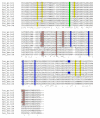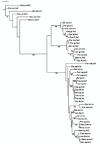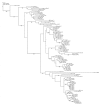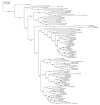New data on the presence of hemocyanin in Plecoptera: recomposing a puzzle
- PMID: 22236413
- PMCID: PMC3391926
- DOI: 10.1673/031.011.15301
New data on the presence of hemocyanin in Plecoptera: recomposing a puzzle
Abstract
The specific role of hemocyanin in Plecoptera (stoneflies) is still not completely understood, since none of the hypotheses advanced have proven fully convincing. Previous data show that mRNA hemocyanin sequences are not present in all Plecoptera, and that hemocyanin does not seem to be uniformly distributed within the order. All species possess hexamerins, which are multifunction proteins that probably originated from hemocyanin. In order to obtain an increasingly detailed picture on the presence and distribution of hemocyanin across the order, this study presents new data regarding nymphs and adults of selected Plecoptera species. Results confirm that the hemocyanin expression differs among nymphs in the studied stonefly species. Even though previous studies have found hemocyanin in adults of two stonefly species it was not detected in the present study, even in species where nymphs show hemocyanin, suggesting that the physiological need of this protein can change during life cycle. The phylogenetic pattern obtained using hemocyanin sequences matches the accepted scheme of traditional phylogeny based on morphology, anatomy, and biology. It is remarkable to note that the hemocyanin conserved region acts like a phylogenetic molecular marker within Plecoptera.
Figures





References
-
- Abascal F, Zardoya R, Posada D. ProtTest: selection of best—fit models of protein evolution. Bioinformatics. 2005;21:2104–2105. - PubMed
-
- Amore V, Belardinelli M, Guerra L, Buonocore F, Fausto AM, Ubero-Pascal N, Fochetti R. Do all stonefly nymphs have respiratory proteins? Further data on the presence of hemocyanin in the larval stages of Plecoptera species. Insect Molecular Biology. 2009;18:203–211. - PubMed
-
- Amore V, Fochetti R. Present knowledge on the presence of hemocyanin in stoneflies (Insecta: Plecoptera). Aquatic Insects. 2009;31(4):577–583.
-
- Amore V, Gaetani B, Fochetti R. Lack of hemocyanin in Oriental Plecoptera and multifunctionality of the protein in larvae. Oriental Insect. 2010;44:429–446.
-
- Amore V, Puig García MA, Timperio AM, Egidi G, Ubero-Pascal N, Fochetti R. Comparative proteomic analysis of hemocyanins in Dinocras cephalotes and Perla marginata (Plecoptera). Environmental Entomology. 2011;40(1):167–171. - PubMed
Publication types
MeSH terms
Substances
LinkOut - more resources
Full Text Sources

